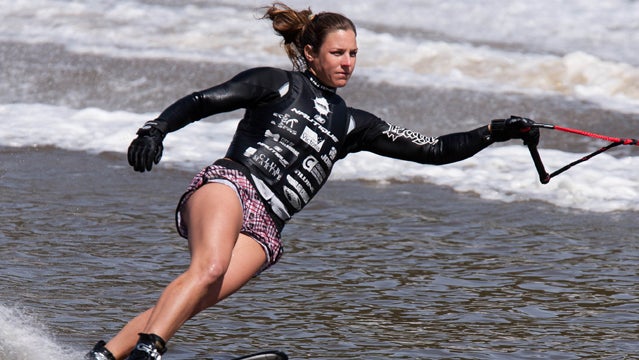We posed your question to pro slalom water skier . Since he started skiing 20 years ago, the 24-year-old has been racking up podium spots and is currently ranked number one in his age group in his home state of California, and 27th in the world. Below, the exercises he recommends to hit the water in top form:
WARM UP
With other sports, warming up is a no-brainer, but most people—even pros—forget to warm up before water skiing. “If you don’t warm up and you go out there, your body is going at 100 percent, and it’s a shock,” Detrick says. He likes to jog a quarter to a half mile to work up a sweat and elevate his heart rate. Then he does plyometric and stretching exercises: high knees, booty kickers, and lunges with a twist to loosen up his core, hip flexors, and psoas muscles. Finally, he’ll do what he calls the “lean drill.” Take a waterskiing rope and tie it to a tree, pole, or something sturdy, then lean against it. “You want to get into an ideal skiing position,” Detrick says, which should look something like you’re playing tug-of-war, with your feet out in front of you, and your hips up, not sitting down.
Check out Detrick’s warm-up video to see how it’s done:
CORE EXERCISES
“One of the biggest things I focus on is core strength, and core stability,” Detrick says. “People don’t realize how strenuous water skiing is on the body. One of the hardest parts is just getting up.” Because you’re pulling with your upper body, and pushing against the water with your lower body, the place where they connect—your core—needs to be solid.
Detrick is a fan of the plank because it’s effective (it works your abs, back, and stabilizer muscles), easy to do anywhere, and can be endlessly modified. He likes to hold the for a minute, then switch it up. He’ll do side planks, one-legged planks, one-armed planks, planking in push-up position, and with his arms extended. To start, he recommends holding plank position for as long as you can, then switching to a side plank.
SKI-SPECIFIC EXERCISES
“One thing that people sometimes don’t take into account is their hand strength and forearm strength,” Detrick says. “Pull-ups and farmer walks help strengthen the hands and the fingers and forearms.” To start doing , Detrick recommends completing five sets of 30-yard walks, holding as much weight as you can in each hand. Detrick uses 45-pound weights.
UPPER AND LOWER BODY EXERCISES
General upper body strength is important, Detrick says. His favorite exercise: . “It ties into that core stability and balance, because instead of being connected to a bar that doesn’t move, the rings make it a little more challenging,” he says. Also, because this is a bodyweight exercise, you can adjust how hard it is by walking your feet out in front of you. “The more you lay down, the harder it is,” Detrick says. He recommends starting out with three sets of 15 rows. If that’s too easy for you, try lifting one leg up.
As for your legs, simple squats and deadlifts should do it. “I like to focus on balance, so if I work one side of my legs, I’ll work the other side as well,” Detrick says. “It doesn’t have to be in the same day. Most people forget about their hamstrings and do so much quad work, and that muscle imbalance can create knee problems.” So make sure that if you work your quads, you don’t neglect your hamstrings.
Detrick strength trains four days a week in his off-season, then two to three days a week when he’s competing.
For more water skiing tips, check out , or follow him on .


